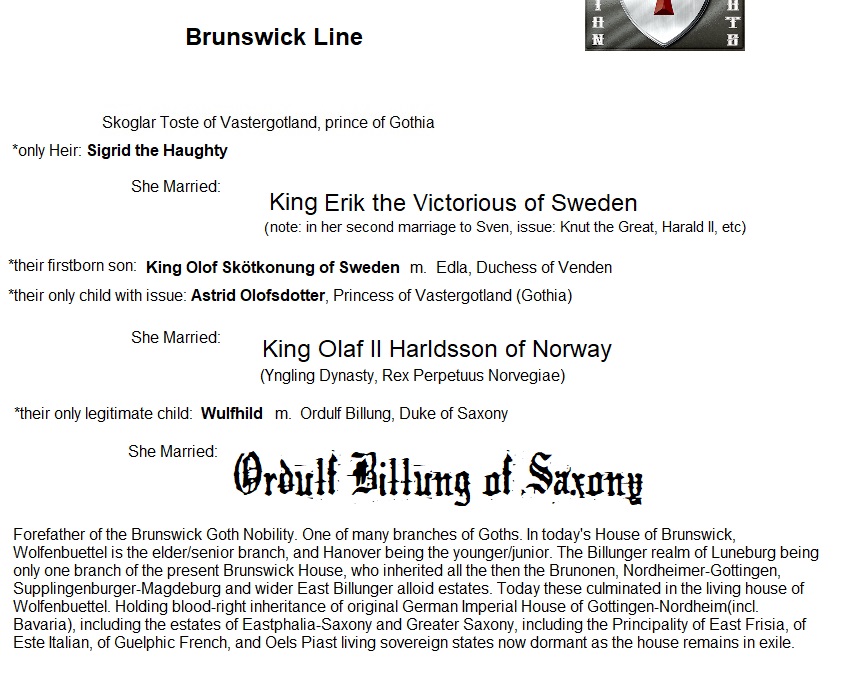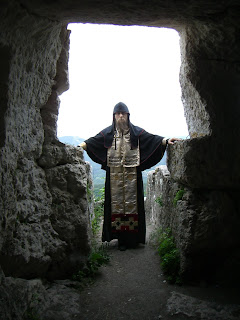The House of Wolfenbuttel-Brunswick Being a Legal Successor to Numerous States of the Goths’ Empire.
INNEHÅLLSFÖRTECKNING
- TILLFÄLLARE FÖR BILLUNGS, SOM HÖGDOMAR OCH KÄMPARE I SAXONY TYSKLAND (OSTROGOTHS Kungliga hus)
- GUELPH LINE OF OSTROGOTH HEIRSHIP
- ESTE LINE OF OSTROGOTH HEIRSHIP
- TITEL TILL PRINSEN GUTINGI (GOTTINGEN) BLEVET ETT HUS TITEL AV HUSET I ESTE-GUELPH BRUNSWICK
- Ättling till GOTHIAs kunglighet i de TOULOUSE LANDSEN i SPANIEN och FRANKRIKE (NU LANGUDOC)
- TOULOSE VISIGOTH HEIRSHIP. MULTIPLE LINES OF GOTHS’ STATE SUCCESSORS WERE UNITED IN OTTO IV, THE DUKE OF BRUNSWICK, WHO WAS CROWNED EMPEROR OF THE HOLY ROMAN EMPIRE
- MOR FÖR ALLA FRANSKA KUNGAR, ARGOTTA OCH DEN TIDIGA FILIEN AV VÄGEN (BRUNSWICK SENIOR FILK)
- DET SVENSKA OCH DANSKA HUSET I GOTHIA
- GOTISK FRAMGÅNG OCH IMPERIELL FRAMGÅNG
- YNGLING-GOTH DYNASTIC HEIRS
- DE KONTINUERLIGA SKYDDEN AV CRIMEAN GOTHIA
- KIEV-RUS GOTH DYNASTIC HEIRSHIP
- ROYALTY OF HUNGARIAN GOTH ESTATES, AS PIAST & POLAND-LITHUANIAN SUCCESSORS
- HISTORICAL AND NEW DYNASTIC CHARTS OF THE HOUSE OF WOLFENBUTTEL-BRUNSWICK
- PRINCE STEPHEN, ANOINTED AS A KING(of one jurisdiction) OF THE GOTHS FOR THE AOCC ARCHDIOCESE OF BERLIN, CONSECRATION CEREMONY IN 2015
- DNA Match of the Royal Capetian Line of Nott-Brunswick
BILLUNGSFÖLJARE
Idag den mest ansedda familjen efterträdare till House of the Amalings (leading dynasty of the Goths), the Royal House of the Ostrogoths of Italy, is most widely known as the Billungs. This house will be demonstrated in addition to a few other kindred houses which have held and continue to hold these estates. The primogeniture family successors of these Gothian houses is demonstrated herein. It is a long established fact of history as being realized in the House of Este-Guelph (head Dynastic Branch being Princes of Wolfenbuettel). The genealogy of the Billung’s successors are found below.

1137 övergick kontrollen över Sachsen till Guelph-dynastin, ättlingar till Wulfhild Billung, äldsta dotter till den sista Billung hertigen, kejsare Lothar III av Supplinburg. Som gick till hans kejserliga efterträdare Henry the Proud, till Henry the Lion of Brunswick och hans son kejsare Otto IV av Brunswick. Brunswick är Europas äldsta levande kungliga (och kejserliga) hus i internationell rätt (även om de jure och förvisade är Brunswick-Wolfenbuettel giltigt i internationell föreskrivande lag).

Hermannus Billung från Sachsen är en direkt manlig efterträdare till Hengist, Witukind och Gauti.
 Från Hengists tid, Sachsen, kung av Kent, var hans son Aesc kung av Kent, och hans son, Ochta, och hans son Eormenric och hans son Saint Ethelbert I, och hans son Aethelbert och hans son Eadbald och hans son Eormenred av Sachsen var alla kungar i Kent England. Han hade en son son Aethelberht som förblev en Lord i Sachsen, och hans son också en Graf i Sachsen, var Billung von Wenden, enligt en berättelse. I andra konton Aethelbert II var kung av Kent söner återvände till Sachsen, känd som Billings (Billungs) av Sachsen. De flesta släktforskningar går åtminstone tillbaka till "Brunhart Billung I. von Stubenskorn Graf i Sachsen", greve av Thuringa var son Aethelbert. Bror till denna Bruno I var Amelung I Billung (vars linjer är dokumenterade ända fram till år 1137 när de utrotades och deras sista kvinnliga arving gifte sig med d'Este-Guelph manliga arvinge (av Brunswick). En annan gren av Billings kontrollerade Northmark, under Wichman den äldre. Vår huvudsakliga gren av Billungs kontrollerade den norra Billungermarsen. Kombinerade dessa var ett stort område. Amelung I födde Bennid I Billung, som födde Amelung II Billung, som födde Amelung III Billung som inte lyckades producera arvingar i 9th århundrade. Linjen fortsatte sedan via Bruno, som nedan, tills Henry Leo (lejonet) i Brunswick, och till hans son kejsare Otto IV von Brunswick och de levande juridiska efterträdarna idag.
Från Hengists tid, Sachsen, kung av Kent, var hans son Aesc kung av Kent, och hans son, Ochta, och hans son Eormenric och hans son Saint Ethelbert I, och hans son Aethelbert och hans son Eadbald och hans son Eormenred av Sachsen var alla kungar i Kent England. Han hade en son son Aethelberht som förblev en Lord i Sachsen, och hans son också en Graf i Sachsen, var Billung von Wenden, enligt en berättelse. I andra konton Aethelbert II var kung av Kent söner återvände till Sachsen, känd som Billings (Billungs) av Sachsen. De flesta släktforskningar går åtminstone tillbaka till "Brunhart Billung I. von Stubenskorn Graf i Sachsen", greve av Thuringa var son Aethelbert. Bror till denna Bruno I var Amelung I Billung (vars linjer är dokumenterade ända fram till år 1137 när de utrotades och deras sista kvinnliga arving gifte sig med d'Este-Guelph manliga arvinge (av Brunswick). En annan gren av Billings kontrollerade Northmark, under Wichman den äldre. Vår huvudsakliga gren av Billungs kontrollerade den norra Billungermarsen. Kombinerade dessa var ett stort område. Amelung I födde Bennid I Billung, som födde Amelung II Billung, som födde Amelung III Billung som inte lyckades producera arvingar i 9th århundrade. Linjen fortsatte sedan via Bruno, som nedan, tills Henry Leo (lejonet) i Brunswick, och till hans son kejsare Otto IV von Brunswick och de levande juridiska efterträdarna idag.
Brunswick Welfens vapensköld (omkring 1200) från Welfs VI: s grav. och Welfs VII. i St. Johannes baptist (Steingaden); ursprungligen: blått lejon på guldbakgrund (idag i Bayerns nationalmuseum, München). Helmzier, två buffelhorn dekorerade med påfågelfjädrar, har överlämnats till Welfen i Braunschweig sedan 1290, och de kommer senare att bli dagens skäror. Vapenskölden från herrarna från Ravensburg (Beienburg) i Zürichs vapensköld, som var i tjänst för Welf Henry the Lion, visar både lejonet (stående) och buffelhornen dekorerade med påfågelfjädrar.
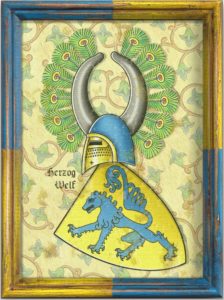
Nedan följer de viktigaste alloiderna (de ärftliga gårdarna) som deras släktforskning ned till huvudlinjerna idag i Brunswick-Wolfenbuettel. Det visas tillsammans med Gottingen-furstendömet som går ner (inklusive Sachsen genom Henry lejonet etc).
(Note: 1. Gottingen was spelled Swedish Gutingi in the oldest documents. 2. The Gottingen alloid being from Woden-born Emperor Witekind (Saxony Dynasty) to his wife Geva, the daughter of the Haithabu King Gotterick of Denmark, the King of the primary realm called Gothia at that time in Scandinavia.)

På Brunoid-linjen kan du se hur det gick till Brunswicks förfader kejsare Lothaire och familjens övriga saxiska kejsare.
Brunoids var också hertigarna av Frisia. Deras rike av den tiden (omkring 900 AD) använde alla Runes på deras mynt, av den äldre Futhark-versionen. Här är ett mynt från den perioden:

Mer om de saxiska tyska runorna finns på: http://celticorthodoxy.com/2020/04/hundreds-of-older-german-runes-demonstrate-the-scythian-goth-kinship-in-viking-and-saxon-nations-directly-linked-to-wolfenbuettel-brunswick/
Husdiagram:
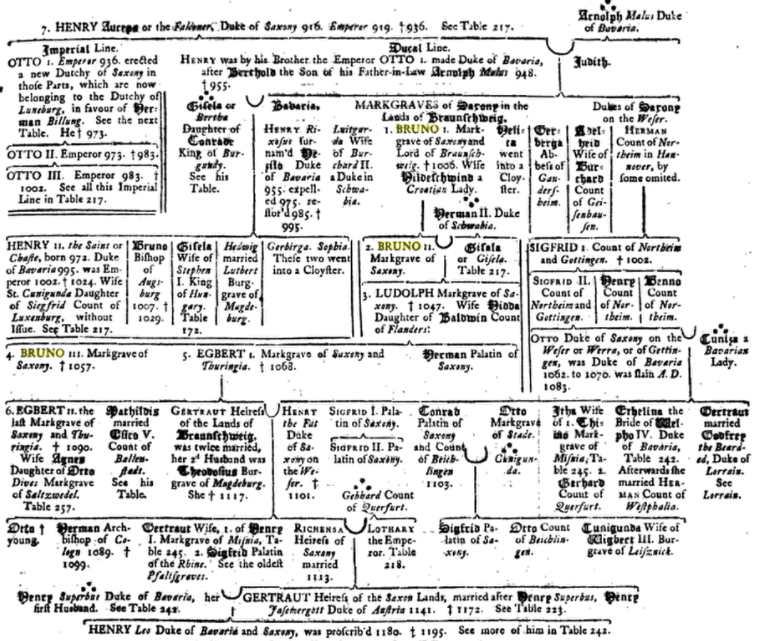
Som du kan se (ovan) I Butlers genealogiska diagram, är Göttingen också utbytbar med Sachsen på Weser, liksom med Nordheim.
| Billunger Imperial Dynasty (Kings of Vendi, Dukes of Billunger March, Nordmark and Ostmark, Dukes of all Saxony, Emperors) |
| Wislaus III, first King of the Vendi (Vandals) and Oborites. (father of 14 successive Kings of the Wends) at the Baltic. |
| Aribert I, second King of the Vendi (Vandals) and Oborites Father of King Aribert II, King of the Wends. |
| Brunhart Billung I. von Stubenskorn Count in Saxony, Woden-born, Count of Thuringa, Prince of Kent. Was second-born son of Aribert. |
| Billung von Wenden, brother of Amelung, princeps militiae, Duke of Saxony |
| Amelung III Billung, Marshal of Saxony, Duke Luneburg / Billunger March |
| Ordulf Billung, Duke of N E Saxony (Billunger March Pomerania / Poland region) + Wulfhild of Gothia, Sweden and Norway |
| Wulfhild Billunger of Saxony. Eldest dau of Magnus, Heiress of the Dukedom Saxony + Elector Henry the Black d’Este-Guelph, Duke of Bavaria |
| Emperor Henry the Proud of Brunswick, inherited senior male estates of Guelph and ruled from the Baltic to Sicily. His duchy of Saxony alone was larger than half of Germany. The pope cancelled his Imperial election for Conrad. |
| Henry the Lion of Brunswick, Heir of all Imperial estates at 10 years old. Fully occupied Wends lands and took control. Henry’s daughter Mechtild married the senior king of the Wends, to give back some Wends lands to form the Mecklenburg house. |
| Emperor Otto IV, Duke of Brunswick, King of Germany, Crowned Holy Roman Emperor |
| Otto the Child, successor of Brunswick, in Denmark was made count of Garding and Thetesbüll in Schleswig Holstein as a Danish prince through his mother Helena Regent, princess and duchess + Ascanian Mechtild/Matilda of Brandenburg, of the Billunger line via Elicke, the younger dau of Magnus Billung and the Ascanian Counts |
| Emperor Frederick I Duke of Wolfenbüttel-Brunswick, Crowned King of Germany, Holy Roman Emperor, he and his brothers re-took Brandenburg per the Billunger and Ascanian rights |
| Duke August the Younger, although was last in line of succession to Wolfenbüttel -Brunswick because his mother Ursula was Ascanian dau of Duke Francis I of Saxe-Lauenburg + Elisabeth Sophie of Mecklenburg(Vendi) whose heir Ferdinand Albert received the seconditure of Bevern- Wolfenbüttel |
| Wolfenbüttel Mini-Emperors. The ‘elder-branch’ Successors continually Emperors of states across the continent with continued Military rank higher than Emperor as Commander-in-Chief of Prussia, Austria, Poland, France, Senior branch over Hanover etc. Cont’d claim of estates linked with the “greater domains”. |
GUELPH LINE OF OSTROGOTH HEIRSHIP
| Guelph Imperial Dynasty
(Princes of Scyrii, Kings of Italy, of Burgundy, and of Lombardia, Counts of Genoa, incl Genovese Crimean Gothia, and Altdorf in Swabia, Margraves of Milan, Dukes of Bavaria, Carinthia, and other Italian Ostrogothic estates) |
| Pharamond, King of Sicambrian Franks + Princess Argotta dau of Emperor Theodoric of Gothia and Italy |
| Edico, King of the Scyri, Herulii and Rugii, father of Odoacre |
| Arnoldus, of Franks, G.father of Charlemagne & Carolingian Emperors |
| Ruthardus of Altdorf, father of Guelph I of Bavaria |
| Adalbert III di Lucca (Margrave) of Tuscany |
| Gerberga of Burgundy, ancestress of Hohenstaufen, her mother was 6th G granddaughter of Charlemagne, father was Guelph Conrad King of Burgundy |
| Cunigunda, Heiress dau of Guelph II + Azo II of Mlian, became Marquess of Este 11K mansi of land of Elisina Lombardy + Azo Prince of Este |
| Guelph III, brother of Cunigunda Duke of Carinthia and Marqis of Verona incl Tyrol & Rhoetian Alps |
| Rudolf II, Count of Altorf and Ravensburg. (Some Pre-Charlemagne alloidial estates) |
| Guelph IV Duke of Bavaria, sone of Azzo II and Cunigunda of Altorf Swabian Elder line of Guelph |
| Guelph V + Mathilda Este heiress of all estates. Passed to his Elder brother, Henry the Black of Brunswick |
| Guelph VI, younger bro of Henry the Proud, retained Altorf and Ravensburg, passing to sister Judith and husband Hohenstaufen Emperor Fredrick and jealous sons the rival Emperors |
| Henry the Lion of Brunswick, Heir of all Imperial estates at 10 years old. Although occupied, his sons repossessed all estates. |
| Emperor Otto IV von Brunswick |
| Emperor Frederick I Duke of Wolfenbüttel-Brunswick, Crowned King of Germany, Holy Roman Emperor |
| Wolfenbüttel Mini-Emperors. The ‘elder-branch’ Successors continually Emperors of states across the continent with continued Military rank higher than Emperor as Commander-in-Chief of Prussia, Austria, Poland, France, Senior branch over Hanover etc. Cont’d claim of estates linked with the “greater domains”. |
ESTE LINE OF OSTROGOTH HEIRSHIP
| Este Imperial Dynasty, Senior branch (Eldest living Italian Royal line, H.R. princes of Italian estates. Today the Younger branch is continuing subordinate to Guelphic Chief Elder branch of the house) Descended from old Actius in the reign of Tarquinius Priscus, King of the Romans, whose offspring were senators, one of them, Marcus Actius (Attius), married Julia Major, sister of Julius Caesar, by whom begat Actia, 2nd wife of Caius Octavius and mother of Augustus Caesar. |
| Cajus Actius, Prince of Este, 390AD Julian Este Imp House of Caesar, Biblical House of Philippians 4:22 KJV ” All the Saints salute you, chiefly they that are of Caesar’s household.” |
| | |
| Caius Actius II. Prince, or Lord of Este, 402 *This line of pedigree is an exact translation of the M.S. compiled by the late Count de Chambord, and in his hand- (and in Anderson’s Genealogies) |
| | |
| Comte de Chambord’s Table of Este. Bonifacius, of Este, Lord of Feltro, died 556 ; his son was Valerianus, of Este, Lord of Feltro, killed in battle 550 ; his son was Gundelhard, Prince of Este, Feltro, and Monfelice, major-domo of Dagobert, King of France, 636; his son was Heribert, Lord of Este, 694; |
| | |
| his son was Ernest, Lord of Este, killed 752; his son was Henry I., created by Charlemagne Prince of Tarvis and Markgrave of Este, he died 780 ; his son was Berengarius, Markgrave of Este and Lord of Tarvis, died 840 ; his son was Otto II., Markgrave of Este and Tarvis, died 898; |
| | |
| his son was Sigfried I(or Albertus / Obertus / Sigbertus)., Count of Este, Lord of Lucca and Parma, died 954 ; his son was Azo II., Count of Este, Margrave of Milan and Genoa, Lord of Placentia and Reggio, made Imperial Vicar by the Emperor Otto I., he married Kunigunde von Altdorf, dau of Welf III, and died 970; |
| | |
| his son was Theobald I., Markgrave of Ferrara and Verona, Count of Canossa, Lord of Lucca, Placentia, Parma, and Reggio ; his son was Hugh III., Markgrave of Este, Milan, Genoa, Tuscany, and Stadtholder of Italy ; died 1014; |
| | |
| his son was Azo IV., by some called Azo III., the Great, Markgrave of Este; his son Azo VI., Markgrave of Este, he died 1055 ; his uncle was Welpho V (Guelph V)., Duke of Bavaria and ancestor of the House of Brunswick (end quote of Comte de Chambord’s Table of Este.) and he married Matilda, the so-called heiress of all the Este (Italian) estates. |
| | |
| Oberto Albert Azzo II (son of Albert Azzo I), Comte de Luni(Toscane-Italie), Marquis de Ligurie(It) et Milan(It), Genova, et al. + Alde de Saxe, Imperial Princess of the Holy Roman Empire, dau of Otto II (Ottonian Dynasty) died 1097 |
| | |
| Immilla Irmengarde d’ORIATE, dau of Olderic-Manfred II, Comte de Vintmille(Liguria-Italy), Marquis of Turin etc, and Bertha Obertini of Milan+ Ekbert ler Billungen Brunoid de Brunswick, died 1078 |
| | |
| Gertrude of Brunswick, dau of Irmangarde and Ekbert,, of Imperial Brunoid Dynasty alloid of Brunswick and East Frisia. + Henri le Gras Comte de NORTHEIM, died 1117 |
| | |
| Bonifacius(Bonifazio I d’Este), Prince of Ferrara, Mantua, Lucca, Parma, Modena, Placentia, Regio, Pisa, Spoleto, Ancona, and Tuscany |
| | |
| Azzo IV, Duke of Milan, Prince of Este + Ferrara to Tuscany |
| | |
| Emperor Henry the Proud d’Este von Brunswick, Senior Branch of Este. The Younger branch went to Azzo d’Este VI (1170–1212) who became podestà of Mantua and Verona. |
| | |
| Henry the Lion of Brunswick, Heir of all Imperial estates at 10 years old. Although occupied, his sons repossessed all estates. |
| | |
| Emperor Otto IV, Duke of Brunswick, King of Germany, Crowned Holy Roman Emperor (re-occupied Tuscany and re-conquered all Italian estates to Sicily) |
| | |
| Emperor Frederick I Duke of Wolfenbüttel-Brunswick, Crowned King of Germany, Holy Roman Emperor |
| | |
| Wolfenbüttel Mini-Emperors. The ‘elder-branch’ Successors continually Emperors of states across the continent with continued Military rank higher than Emperor as Commander-in-Chief of Prussia, Austria, Poland, France, Senior branch over Hanover etc. Cont’d claim of estates linked with the “greater domains”. |
BRUNSWICK TITEL "PRINS OF GUTINGI / GOTTINGEN"
När House of Brunswick framför allt använde titeln "Prince of Gutingi / Göttingen" var det mellan två Brunswick-kejsare, Otto IV och kejsare Friedrich I von Brunswick [officiella HRE-kejsare. Som ättlingar till de saxiska kejsarna hade huset högsta rättigheter som Este-Guelph. Som var i början av Guelph Ghibbline-krig, Templar vs Hospitaller].
The line listed in several encyclopedias shows Witukind, King of Saxony married Geva, the daughter of King Gotterick (of Denmark-Sweden vaster-Gotland). The Scandinavian land over which he was King over was called Gothia. It was understood the Saxony house dowery included a land med after the Kingdom, in Saxony itself called Gottingen. This root line of Gottingen-Brunswick birthed several generations of Emperors of Germany which were also crowned Holy Roman Emperors, ruling as chief dukes of the House of Brunswick (including official heads of the realms of Eastphalia, Westphalia, East Friesland, Sicily, several Italian principalities, French Estates, Duchy of Bavaria, Duchy of Pomerania, in those times) which has continued in more continued successions maintained than any other house today.
The Ottonian and Gottingen, Brunoid Dynastic Heirship in the Dukes of Brunswick:
| Saxon Imperial Dynasty (E and W Saxony, Ottonian Elder branch) |
Saxon Imperial Dynasty (E and W Saxony, Göttingen Younger branch) |
| Emperor Witekind, King of the Saxons, Woden-born, Prince of Angles, Christian death in 807AD + Geva, dau of Goderic( Göttrick), Haithabu King of Denmark (Gothia) | Emperor Witekind, King of the Saxons, Woden-born, Prince of Angles, death in 807AD + Geva, dau of Goderic( Göttrick ), Haithabu King of Denmark (King of Gothia) |
| | | | |
| Wigebert, son of Wittikindus, his firstborn successor via Geva (daughter of King of Haithabu Denmark) + Sindacilla, dau of Ratbodus, King of Friesland | Wigebert, son of Wittikindus, his firstborn successor via Geva (daughter of King of Haithabu Denmark) + Sindacilla, dau of Ratbodus, King of Friesland |
| | | | |
| Bruno I, senior Duke of Saxony, firstborn of Wigebert using Goth/Viking Runic coins | Bruno I, senior Duke of Saxony, firstborn of Wigebert, Goth/Viking Runic coins |
| | | | |
| Bruno II, Firstborn senior Duke of Saxony and Frisia(mini-Empire), built the City of Braunschweig, kept court at Göttingen | Bruno II, firstborn senior Duke of Saxony and Frisia, built the City of Braunschweig, kept court at Göttingen |
| | | | |
| Emperor Henry I, the Fowler, son of Otto, the younger brother of Bruno II, was King of East Francia and Duke of Saxony. Senior Line of the Ottonian Dynasty of Kings and Emperors | Sigfrid I, Count of Northeim and Göttingen (Founded younger Branch as desdended of Henry the Duke of Bavaria, youngest son of Henry the Fowler) |
| | | | |
| Emperor Ott, eldest son of Henry the Fowler. He was father of Emperor Otto II + Byzantine Princess Theophanu, Empress & Regent of Otto III. All were Kings of Germany, Crowned Holy Roman Emperors |
Otto, Duke of Saxony on the Weser (or of “Old Saxony” Göttingen) Immedinger (Witukindischer) of Nordheim Duke of Bavaria |
| | | | |
| Emperor Otto III, called the Wonder of the World, son of Emperor Otto II and Theophanu of Byzantium. He was assassinated by a Roman Consul’s widow in 1003, and was without issue. | Emperor Henry II, Duke of Bavaria, Duke of Carinthia, King of Italy, King of Germany, HR Emperor. Kept his Imperial court at Göttingen where died. |
| | | | |
| Princess Itha, granddau of Otho I via Richildis. + Rudolf II d’Guelph Count of Altorf and Ravensburg. Ancestor of the Electors of Brandenburg (Pre-Charlemagne alloidial estates) | Henry of Northeim- Göttingen + heiress Gertrude of Imperial Brunoid Dynasty alloid of Brunswick and East Frisia. |
| | | | |
| Kunigunde d’Este Guelph of Altorf, joining estates of both houses. She’s an Ottonian descendant as a Great Great Niece of Emperor Henry II, and named after his wife Empress Cunigunde. He was Holy Roman Emperor, Duke of Bavaria, King & Queen of Germany and Italy, kept the government at Göttingen. | Richenza de NORTHEIM, dau of Gertrude and Henry, + Lothaire II de SUPPLIENBURG, Empereur Romain germanique, Duc de Saxe, Comte de Supplienbourg |
| | | | |
| Emperor Henry the Proud of Brunswick, Ruled the Baltic to Sicily | Holy Roman Emperor Lothar (II) III of Supplingenburg, Duke of Saxony, King of Germany. + Richenza of Northeim Göttingen Saxony, dau of Henry of Norheim and Gertrude of Brunswick. Emperor Lothaire Granted all Imperial properties to his son-in-law, successor, Henry the Proud. |
| | | | |
| Emperor Otto IV, Duke of Brunswick, King of Germany, Crowned Holy Roman Emperor | Gertraut of Brunswick and Supplingenburg Heiress of the Emperor + Emperor Henry the Proud, Duke of Bavaria and Saxony, 6th Saxon Duke raised to the rank of Emperor since Witukind, but Imperial election stopped by the pope. |
| | | | |
| Emperor Frederick I Duke of Wolfenbüttel-Brunswick, Crowned King of Germany, Holy Roman Emperor | Henry the Lion of Brunswick, Heir of all Imperial estates at 10 years old. Although occupied, his sons repossessed all estates. |
| | | | |
| Wolfenbüttel Mini-Emperors. The ‘elder-branch’ Successors continually Emperors of states across the continent with continued Military rank higher than Emperor as Commander-in-Chief of Prussia, Austria, Poland, France, Senior branch over Hanover etc. Cont’d claim of estates linked with the “greater domains”. | Emperor Otto IV, Duke of Brunswick, King of Germany, Crowned Holy Roman Emperor |
| | | |
| Emperor Frederick I Duke of Wolfenbüttel-Brunswick, Crowned King of Germany, Holy Roman Emperor | |
| | | |
| Wolfenbüttel Mini-Emperors. The ‘elder-branch’ Successors continually Emperors of states across the continent with continued Military rank higher than Emperor as Commander-in-Chief of Prussia, Austria, Poland, France, Senior branch over Hanover etc. Cont’d claim of estates linked with the “greater domains”. |
The House of Wolfenbuttel-Brunswick descends of both these lines. Also descends from several other Imperial Dynasties as the only successor, as claimed and maintained in international law in every generation.
Medan Gottingen länge hade varit en alloidisk besittning och kapital för huset, blev godsnamnet "prins av Göttingen" först under denna period, till ära för våra Ottoniska kejsars förfäder som höll sin kejserliga domstol där. Dessa var till stor del av det saxiska-Billung-gotiska huset.
Furstendömet Northeim kallades ibland detsamma som "Göttingen", även om nyligen forskare normalt skiljer dessa som två. Regionen kallades också ”Sachsen vid Weser” strax innan den förenades med kejsaren Lothair och gavs till hans svärson Henry the Proud.

"Agnaterna" (ättlingar till blodlinjen) har hädanefter fortsatt att använda titeln och bibehåller rätten till detta gods i det kejserliga palatset Gutingi. Staten är fortfarande lagligt ett furstendöme idag, dock endast i de jure exilregering. Alla legitima Brunswick-ättlingar är födda med titeln "en prins av Göttingen", och endast huvudhertigen i Brunswick har titeln "Prinsen av Göttingen". Som arvtagare till de största delarna av Billung Sachsen arv, gjorde det Göttingen kejsarpalats med många kejsare passande alloid för Brunswick för det mesta för huset.
Vapenskölden för furstendömet Göttingen är Brunswicks huvudvapen, enligt nedan:
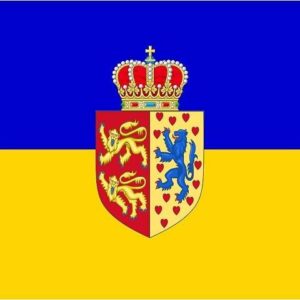 (Observera Wolfenbuettels sista de jure-version av flaggan den var med vitt och blått, inte med guld. Guldet har emellertid använts antikt och utbytbart.)
(Observera Wolfenbuettels sista de jure-version av flaggan den var med vitt och blått, inte med guld. Guldet har emellertid använts antikt och utbytbart.)
Huvudstaden för Brunswick Monarchy har främst varit Göttingen, den var vid andra tillfällen en underordnad sekundärhuvudstad för några av de mindre godterna under den större Brunswick Monarchy. Strategiskt var Brunswick stad huvudstad en tid, och även furstendömet Wolfenbuettel var en bekvämare huvudstad för Stor-Brunswick-Luneburg en tid. De flesta underordnade furstendömen under de senaste 400 åren erkände att de var underordnade att de skrev sina statliga namn som Wolfenbuettel-Luneburg [till exempel], vilket var ett annat furstendöme för de många underordnade furstendömet till Wolfenbuettel-linjen i den högsta ledande grenen i huset som regerade överallt som absolut Monarker, som per definition också var ett mikroimperium i sig, och har förblivit så idag.
De kejserliga kronorna går mycket bredare som man kan läsa om, från Italien till Ryssland, till de sista regerande Piasterna, även om de alla har försvunnit lagligt som hus. Ändå allt vi kan säga så långt vårt forntida och levande hus alltid kan visa, allt härstammar från detta centrala Gutingi / gotiska arv. Många andra medstammarik finns i överflöd som vi återförenas med idag!
More information on this living house is available from the Priory of Salem, Institute of Peace studies, if you write to the coadjutor at marshalofsalem@yahoo.com
Ättling till GOTHIAs kunglighet i de TOULOUSE LANDSEN i SPANIEN och FRANKRIKE (NU LANGUDOC)
Många linjer i det franska högkungliga arvet av Henry the Lion går tillbaka till goterna. En av dessa är linjen från Guelphs, som härstammar från en äldre förälder till Charlemagne. En av de högsta kanske är linjerna till Argotta, mor till alla franska kungar. Det är officiellt en del av den franska historien och så tar vi med det i sitt eget separata kapitel, senare.
Det visigotiska namnet, territoriet och dynastin förblir i titeln Frankrikes adel. Frankrikes jämställdhet (högst rankade lika prinsar) har flera ärftliga furstar av detta rike, och använder anspråket som den större provinsen kallad ”Languedoc”. Läs broschyren av Jean Lafitte och artikeln ”Languedoc, déformation de * Land Goth?”. Dynastiskt är det också demonstrerbart bevarat (som jag ger en smakprov nedan). Den visigotiska familjeföljden bevarades från den ursprungliga Balti-dynastin via den visigotiska prinsessan Brunhilda, farmor till Pepin (och andra visigotiska adelsmän) och överförde därmed rättigheterna till frankerna, senare till de dynastiska ättlingar som var kända som greven i Toulouse och prinsarna i Gothia för ytterligare 800 år. Det ursprungliga Gothia (Visigoth) landriket förblir i namnet “Langeudoc” (Gotlandsland / Langue de Goth), enligt många autentiska register, uppslagsverk etc. Idag kan du också slå upp det på vilken karta som helst. Oavsett om de kallar sitt territorium Langeudoc eller Gothia gör ingen skillnad, eftersom alla är överens om att det är samma plats, samma stam och bara en annan stavning. Det fortsatte lagligt genom den kvinnliga Visigoth Genealogy, även som en titel "Gothia", och senare samma region i allmänhet som Languedoc. Under de flesta generationerna förblev det inom Toulouse-adelens regering. Det gick sedan vidare till deras arving Philip III som var från den tidigare kapetianska dynastin och ner genom alla franska kungar fram till idag. Vi vet att Bourbon House, den kadettiska grenen av den kapetianska dynastin har haft de ursprungliga anslagen med namnet "Gothia" enligt de allmänna historiska böckerna (en som bifogas i bilden). Det ursprungliga territoriet nådde de franska kungarna genom att först passera från den visigotiska prinsessan Brunhilda. Hon gav det till sina arvingar och till den merovingiska kungen Pepin, se: https://gw.geneanet.org/belfast8?lang=en&p=brunhilda+of+toledo&n=germany . Som i den bifogade bilden gick hela Gothia rättmässigt (lagligt) dynamiskt ner från Bernard I till hans arvingar, fram till idag helt konkret. Inte bara kungarna skyddade alla sådana titlar i provinsen, hertigarna och räkningarna avsade aldrig någonsin denna juridiska enhet som kallas Languedoc eller upplöste den på något sätt. Deras påståenden om detta berömda anständiga eller avsäga sig alla rättigheter till denna enhet. Allt detta var länge avgjort. Saker och ting blev bara lite skakiga med den napoleaniska usurpationen under den franska revolutionen. Brunswick-manifestet var att återställa den franska kungen till alla hans rättmässiga titlar, av vilka Napoleon vägrade. Därför gjorde Brunswick gott om alla löften, som befälhavare över hela Preussen, överbefälhavare över hela Österrike och befälhavare (under krigstid) för de jure Frankrike (som beviljats av den rättmätiga kungen av Frankrike vilket ger Brunswick ytterligare myndighet i Frankrike). Observera att Brunswick också har den levande titeln Prins av Göttingen (Gothia) som ett dynastiskt arv, som förblir ett under-furstendöme under hertigdömet Brunswick och Lunenburg, med samma prins som rankas högre (under krigstiden) än alla tre kejsarna. Detta började kriget för att den franska kungen skulle återställas under alla ursprungliga rättmätiga titlar.
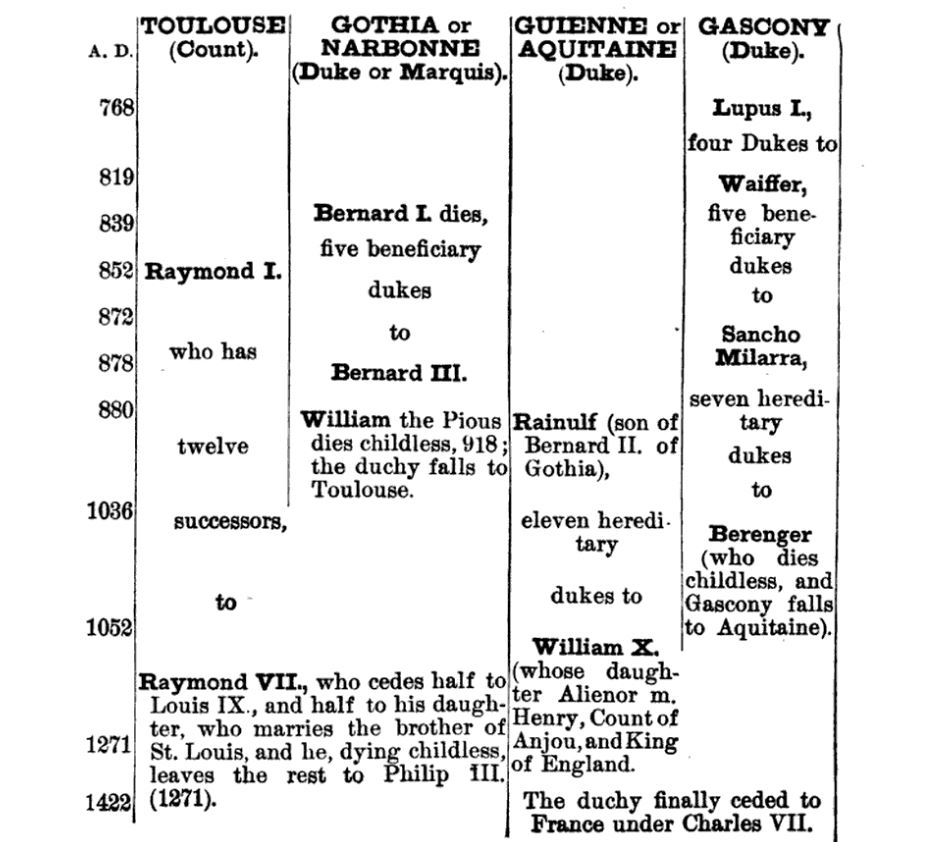
DET SISTA FRANSKA GOTISKA PRINSEN FUNKTIONellt ANVÄNDADE FAMILJETITLEN GOTHIA, TITELEN SOM HAN INÄRVADE FRÅN FADER OCH MORFADER, "PRINSEN I GOTHIA" RAYMOND IV AV TOULOUSE, VAR EN LEADER AV FIRST.
Vilket stort arv goterna har ärvt från Raymond IV, den mäktigaste ledaren för första korståget.
Han var blod efterträdare till Kungliga huset i Gothia som "Princeps Gothiæ", och som greve av Toulouse, hertig av Narbonne och markgrave av Provence. Titeln ”Prince of Gothia” hölls emellertid mer framträdande av hans far och farfar, liksom hans farfar och morföräldrar i många generationer.
Efter hans seger befriade Jerusalem och bysantinerna,
Raymond erbjöds kronan för det nya kungariket Jerusalem. Men han vägrade, eftersom han var ovillig att styra i den stad där Jesus hade lidit. Han sa att han frossade när han tänkte kallas ”kung i Jerusalem”. Det är också troligt att han ville fortsätta belägringen av Tripoli snarare än att stanna kvar i Jerusalem. Men han var också ovillig att ge upp Davids torn i Jerusalem, som han hade tagit efter stadens fall, och det var bara med svårighet att Godfrey av Bouillon kunde ta det från honom.
Raymond deltog i striden vid Ascalon strax efter erövringen av Jerusalem, under vilken en invaderande armé från Egypten besegrades. Raymond ville emellertid ockupera Ascalon själv snarare än att ge det till Godfrey, och i den resulterande tvisten förblev Ascalon obesatt. Det togs inte av korsfararna förrän 1153. Godfrey skyllde honom också för att hans armé inte lyckades fånga Arsuf. När Raymond gick norrut, vintern 1099–1100, var hans första handling en fientlighet mot Bohemond, och erövrade Laodicea från Bohemond och återlämnade den till bysantinerna.
DE TVÅ LINJERNA, VISIGOTH OSTROGOTH VAR FÖRENADE I OTTO IV, DUKE OF BRUNSWICK, SOM VAR KRONAD KEIZER AV DEN HELIGA ROMANSKA EMPIRE
Dessa kungliga linjer av västgoter och östgotar (Balti och Amali-dynastierna) uppdaterades åter i hertig Otto IV av Brunswick, som kröntes som kejsare av det heliga romerska riket under både Brunswick och Aquitaine French Coats of Arms genom sin mors sida (Matilda). Båda sidor av sin mors familj hävdade rivaler på arvet från hertigdömet Toulouse (Gothia). Detta vapen i Frankrike och England förblir i Brunswick idag. För de flesta grenar i Brunswick används den som den äldsta versionen med två lejon och ibland med ett lejon. Även om vissa grenar, inklusive en tid, använde Otto IV versionen av tre lejon.
Det bör noteras att inte bara hans mor var en rivaliserande efterträdare för Toulouse Gothia, utan också en efterträdare för den tidiga grundaren av Templarhuset (Angevin / Anjou). Under en kort period var Otto IV arvtagare till Templar-grundaren, Angevin (Anjou) Adel i Frankrike. Medan idag förblir ingen av de franska arvingarna kända för denna familj, alla utom Brunswick. House of Brunswick påminner dock sällan Frankrike om dessa rättigheter. En till minne åberopades under kriget med Napoleon. Men som överbefälhavare för preussiska, österrikiska och Brunswick allierade arméer fanns det bara erbjudande att hjälpa den sanna franska kungen mot den franska revolutionens våldsamma socialism. Erbjudandet var främst att skydda Hans höghet från övergrepp etc, som alla giltiga och rättvisa suveräner skulle erbjuda. Detta erbjudande utvidgades igen till Napoleon III genom ett fördrag för att hjälpa Brunswick med att återta alla tyska länder under ett imperium.
Denna Angevin och Toulouse (Visigothic) Templar kom delvis genom Henry the Lion's fru Matilda. Hur mycket mer det än kom av Henrys egen arv efter Billungs hus (Ostrogoths).
Som mor till kejsaren Otto IV känner vi igen honom och resten av hans bröder var arvtagare till Angevin (Anjou), Aquitaine och hela Frankrike. Så många gotiska påståenden återupplivades i Otto IV att hans efterträdare gjorde det till lag att använda titeln Prince of Gottingen / Gutingi. Denna ytterligare franska gren från hans moderarv, förvärrade dessa mycket längre än Amelung Billings släktforskning, och den guelfiska linjen till Argotta och de mest uppskattade husen för de gotiska kejsarna.
MOR FÖR ALLA FRANSKA KUNGAR, ARGOTTA OCH DEN TIDIGA FILIEN AV VÄGEN (BRUNSWICK SENIOR FILK)
The Frankish Kings absorbed and took over a major Gothian title for the part of France now known today as Langudoc. Many know prince Raymond IV of Gothia and Toulouse led the biggest armies of the 1st Crusade (and that he was equal peer of the King of France). Ever since the Frankish prince Alberici married Argotta, the daughter of Theodemir Amalaus King of Gothia, the sister of Theodoric Amali King of Gothia & Italy, and had a son Duke VAUBERTUS (or Wambertus) the title stuck and is in the official histories. Thus making him not only Heir of Gothia via his mother, but also the Grandson of the Sicambrian-Ukrainian descended Davidic King Pharamond on his father’s side (an established link in old Gothia Crimea where they still use the Gothic runes in their liturgy, it’s more similar to Greek letters). It’s also indisputed that the next in succession Gothian son Arnoldus founded the line of which Charlemagne is descended. The Guelphs (Brunswick House) is descended from the Grandaughter of Arnoldus, Princess Gertrude.
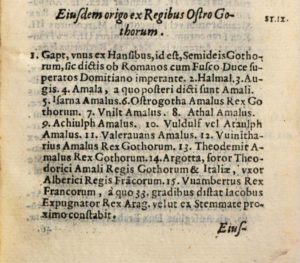
Denna släktforskningskopia är från en omtryck från 1628 av Testamentum Magni, Regis Norvegiae, först skriven 1277; –Judicium de scriptis Gasparis Scioppii contra Johannem Vossium et Famianum Stradam; –De variis febrium generibus; –Praelectiones poeticae, 1674; –Conclusiones et decreta Papae et Concilii Hispanici secreti, anno 1615 incepti, et usque ad annum 1627 perducti. Latin. Chartaceus, sek. xvii Quarto [11.247] (som den är katalogiserad på British Museum).
Släktforskning, som relaterar till dessa officiella frågor om många nationers suveränitet, har bevakats som en av de mest tillförlitliga uppgifter som någonsin funnits. Allierade nationer garanterade denna integritet i krig för att skydda sådana rättigheter till genealogisk arv osv. Idag har vi en del internationell lag som fortfarande skyddar våra exilregeringar i kombination med flera internationella fördrag. Släktforskningarna kan ses som en av de mest exakta uppgifter som finns. Kristi släktforskning är också ett exempel där uppgifterna finns tillgängliga och har använts för att bevisa en poäng. Nu borde vi lika bra som det rör kristlig egendom och att vara en bra förvaltare av vad han har gett. Andersons släktforskning, publicerad 1732, är allmänt överens om att vara absolut. Som publicerats nedan finner vi att linjen upprepade linjen Argotta från de ostrogotiska kungarna och hennes äktenskap med Alberici, en prins av frankerna. ”Moder till alla franska kungar” är Argotta, vi har till och med i själva namnet ett bevis på en gudomlig arv. House of Brunswick (Guelphs) är av denna tidiga rot. D'Este Guelph Brunswick-Wolfenbuettel-Oels, Senior Branch, ...

THE BALTI-GOTH DYNASTIC HEIRS
| Balti Goth Dynasty (Imp Gothia) |
| Theodoric I Balthas of Visigoths |
| Amalric
King of the Visigoths |
| Clodion, “le Chevelu”, King of France, son of Pharamond, King of France and Agotta, Queen, dau of Emperor Theodoric of Gothorum |
| Visigothic Princess Brunhilda + Sigebert I, King of Franks / Austrasia |
| Princess Chlodeswintha, dau of Sigebert & Brunhilda of Visigoths + Recaredo I King of the Visigoths |
| Bernardius Comte de Septimania, Margrave of Gothia, holding the independent allodial estates |
| Adalbertus, Duke of Alsatia (Alsace), son of Adalric, Duke of Alstatia, head of the Ethiconides, Major Domus of Allemania |
| Raymond IV, Prince of Gothia (Langudoc) Count of Toulouse, Provence and Narbone, peer/equal of the King of France. The head prince of the first Crusade, formed the earliest Knights Templar. |
| Matilda, Plantagenet & Angevin Princess of England, Normandy, Anjou, and Aquitaine, Head of Gothia Langudoc + Henry the Lion of Brunswick, Duke of Saxony and Bavaria |
| Emperor Otto IV, Duke of Brunswick, From 1196 was Duke of Aquitaine which covered most of France, incl Gothia / Langudoc, Was King Richard made him chief successor of the entire Angevin Empire(Britain, France, Jerusalem etc), withheld by the competing Capet line. 1197 crowned King of Germany, also King of Burgundy, Crowned Holy Roman Emperor 1206 |
| Emperor Frederick I Duke of Wolfenbüttel-Brunswick, Crowned King of Germany, Holy Roman Emperor |
| Wolfenbüttel Mini-Emperors. The ‘elder-branch’ Successors continually Emperors of states across the continent with continued Military rank higher than Emperor as Commander-in-Chief of Prussia, Austria, Poland, France, Senior branch over Hanover etc. Cont’d claim of estates linked with the “greater domains”. |
GOTISK FRAMGÅNG OCH IMPERIELL FRAMGÅNG
Detta ämne kan inte lämnas utan att nämna inte bara titlarna på den gotiska prinsen, utan också på det många alloidiska blodarvet från kejsargårdarna till de sista kejsarna i flera av de antika linjer som gick till detta hus.
Så många alloidala kejserliga familjer gick till de enda manliga arvingarna (Brunswick d'Este-Guelph). Detta är ytterligare ett vittne om att detta är en stor gudomlig gåva som vi alltid kallar, "av Guds nåd". Vid samma tid som kungadynastin i gotiska huset överfördes framgångsrikt och arv av huset i Brunswick i Henry the Lion d'Este-Guelph, var tiden för kejserliga arv. Dessa arv var inte bara från denna period från 900 AD till 1200 med kejsare Otto IV i Brunswick, men det fortsatte mycket längre fram.
1400 AD valdes hertigen Frederik Wolfenbuettel-Brunswick till kejsare,
På 1600-talet fortsatte Piasts sista blodlinje med Brunswicks,
I mitten av 1700-talet blev en annan Wolfenbuettel-Brunswick hertig Ivan VI kejsare över hela Ryssland.
Det fanns redan så många kejserliga linjer (ingen av dem Hapsburg eller preussiska familjer kan hävda, eftersom deras blod bara var räkningar, av nyare hus). Men föräldrarna och morföräldrarna till Henry the Lion som var kejsare och de överförde blodets rättigheter till imperiet till denna linje, framför allt andra.
Även om linjen redan hade rätt till de högsta kungadömena (dvs. det ursprungliga större Sachsen, hertigdömet sedan Henrik lejonets tid och de forntida kungarna i Sachsen), hölls det ofta av de facto kejsare. Kejsare Lothar III (ibland kallad Lothar II) i Supplingenburg beviljade den dåvarande chefen för House of (d'Este-Guelph), Henry the Proud, den fulla arvsbeviset för att vara kejsaren. Henrys kejserliga styre 1137-38 var ”från hav till hav, från Danmark till Sicilien”, som hans biskop Otto von Feising hade skrytt.
Kejsar Lothars upprättande av Henrys arv utvidgade också hans territorier, och det inkluderade överföring av den kejserliga insignierna (Reichskleinodien).
Denna arv hade i årtionden förstått, och var termer för hela Lothars styre, för stöd från de flera provinsiella hertigarna i Sachsen. Det spåras att detta stöd även från hans val till hans död endast hade säkrats genom kejsarens enda dotter med Henrys son. Kejsaren Lothar hade sitt enda barn, Gertrude, gift med sonen till Henry den svarta sonen Henry the Proud. Utan detta äktenskap hade hans egen kejserliga arv inte erkänts av de många hertigarna i Henrys domäner.
From long before that time, up until today, the House of Brunswick has remained a the oldest living and most senior Imperial house of Germany(incl. beyond German borders), with an equal right to be elected to the throne of Emperor. This is of the original Reich of Charlemagne, under it’s laws which required unbiased voting for an Emperor that only holds that rank during war time. Afterwards is to go back as an equal prince. This mode was how Brunswick continued to operate, and was still often called to be commander-in-chief at times of great wars. The original order had been long usruped by the likes of the Hapsburgs and Prussians. From the inception of such illegal actions it has been met in the fields of battle and has continued even to this day, as shown in the existing treaty of Ham that the current head of House has rights to claim to exercise a right as Emperor of all German lands. The rights to all these estates have continued long since the Guelph and Ghibelline wars/rivalries, and the original stealing of 90% of the estate known as the Duchy of Saxony, of which is still contended for (from Eastphalia to Westphalia etc as the True Saxony borders) and is in the main coat of arms of the house (the coat of arms of the last King of Saxony). For much of the time this senior house has had wars with the current usurpers, Habsburg who have not done true valid elections, where all princes would have an equal chance to be Emperor. So the senior branch of (Wolfenbuettel)Brunswick refused to be electors, unlike the junior branch of (Hanover)Brunswick. Wolfenbuettel-Brunswick maintained seniority in the general college of princes. None of the college of princes nor the electors of the time would recognize Hanover’s illegal creation as a new elector(just to make more votes for Hapsburg, their only supporter). For much of the time till the destructions of Napoleon, the Brunswick’s held title of “Commander-in-Chief” over the entire Empire, a rank higher than the Kaiser in time of war. Multiple dukes held this title also during the war with Napoleon, as in previous centuries over the larger bodies of the Germanic nations. So in practice still the claim had remained somewhat recognized.
The Angevin territories (Britain, France and Jerusalem) were also inherited by the House of Brunswick, although has been in a rival dispute ongoing with the Capets. Several of the alloids of the House of Brunswick continue in the house as being older than the Carolingian Empire itself, still ongoing in a chief Imperial bloodline.
Brunswick-Gottingen (named after the Saxon King Witukind’s Danish wife and her line of Gothia Denmark-Sweden) was the allodial capital for the older Saxon Emperors of which the dukes of Brunswick descend. The transmission of the Imperial mantle continued from one Saxony duke to the next, Otto IV of Brunswick. Henry the Lion’s son, Otto IV von Brunswick also wore the Imperial insignia that was originally belonging to the house, when he was officially crowned Emperor, and recognized worldwide. There was one condition from the pope, that he would not retake the family’s possessions of Sicily. He broke that promise and for that reason was excommunicated, however the family from that day, till today has never abdicated this right and title of right to be Emperor, nor the titles that are most foundational of the Empire, as Europe’s oldest and most senior living Royal family (in legal international and prescriptive law).
DET SVENSKA OCH DANSKA HUSET I GOTHIA
Idag (fram till 1972) har Danes härskande hus (Glucksburgs hus) använt titeln King of the Goths.
Denna namngivning av Gothia går tillbaka till antiken. Hela området där, Danmark och södra Sverige har alla kallats Gothia. Det hade också en uppdelning av sin egen Ostrogothia och Westrogothia, etc. Medan dessa gränser ofta förändrades, var det fortfarande förstås att regionens övergripande namn var Gothia (och många historiker skrev Geats, jämförde dem med Samogetia, och de stammarna runt Lettland och åkte ner i Billunger landar Westerward till runt Luneburg).
The Swedish Goths and Danes were some of the greatest kindred allies of the House of Brunswick (especially loyal after Henry the Lion’s wars against various tyrannical German Emperors). Generation after generation of marriages continued with the Kiev Rus Vikings that were entertwined with the Danish Goth Royals.
One such marriage (Otto I the Child, to Princess Helena of the Danes) was contracted during the tumultuous period of the forced re-creation of Brunswick-Luneburg. Several gifts of the realm of Gothia were given from the King of Denmark to Otto. The re-creation of Brunswick however was accomplished by a trickery when Duke Otto the child, under duress was forced to “voluntarily” part with the Dynastic realms of Greater Saxony, of Italy, and the eastern Goth lands such as Pomerania where all would be returned back as one fief of the Empire. In 1235 he was forced to rename his vast domains into a re-consolidated Dukedom of Brunswick-Luneburg. Many have eroneously reported that this limited the domains of Brunswick. While it may appear limiting on it’s face, this was only as it stood within the Holy Roman Empire (HRE) jurisdiction, while Brunswick continued itself as an Empire across the continent. It was common that Dukedoms operated as the highest form of an Empire in parallel to the HRE, as other ducal Monarchies operated, such as the “Hapsburg Empire” with numerous subordinate principalities and other vassals. Hapsburg, like other houses of great Empires, had no higher rank than Dukes in the HRE (as dukes were higher than princes in German law). For Brunswick this claim was just as great, and arguably continued on greater than Austria in many respects. The post-1235 domains included several principalities, and succession rights in at far corners of the continent, with all states continuing their subordinations and loyalties as vassals of his house.
The Luneburg house (subordinent principality and alloid of the Dukedom) is most well known as a descendant branch of the House of Gothia. It is so visibly near to the region that is known to the name Gothaland, and holds the same coat of arms of that land as the primary shields of Brunswick-Luneburg.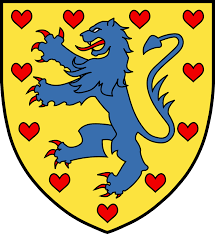
The coat of arms for the Luneburg principality itself bears witness, with the design of the blue lion and hearts having it’s history as the main arms of Scandinavian Gothia, also while it was the primary house of the Kiev-Rus. Smaller provinces of Gothia would have less than 3 Swedish or Danish lions. We see this heraldry reflective in states also under subordination of Brunswick, such as Holstein, and from which the family descends in Schleswig and Glucksburg. This unmistakable symbol of the Gothis region of Scandinavia is the Blue Lion on the golden background, with the red hearts.
Genealogies tied to the arms are also most forthcoming within the house of Wolfenbuttel-Brunswick and it’s ancestors.
A major Gothian line of Brunswick goes back to Wulhild of Saxony, the daughter of Olaf II, King of Norway. Her mother was of the Royal House of Gothia. A chart has been put together as follows:
YNGLING-GOTH DYNASTY HEIRS
| Yngling Dynasty (Emperors/Kings of Scandinavian Gothenland) |
| Froda or Frey called Yngve |
| Gotharus Ottar Vendelkråka |
| Erik VIII the Victorius, King of Sweden
+Sigrid, Queen of all Gothenland, dau of Viking Skoglar Tosti (and Mother of Knut the Great) |
| Olaus Skötkonung
King of Gothia |
| Astrid Olofsdotter, Princess of Gothia
+ King Olaf II Harldsson of Norway Rex Perpetuus Norvegiae |
| Wulfhild of Gothia, Sweden and Norway + Ordulf Billung of Saxony |
| Emperor Henry the Proud of Brunswick, Ruled the Baltic to Sicily |
| William of Winchester, son of Henry the Lion. Brother of Emperor Otto IV, Duke of Brunswick, King of Germany, Crowned Holy Roman Emperor |
| Otto the Child, successor of Brunswick, in Denmark was made count of Garding and Thetesbüll in Schleswig Holstein as a Danish prince through his mother Helena Regent, princess and duchess + Ascanian Mechtild/Matilda of Brandenburg Ascanian Billunger Saxony |
| Emperor Frederick I Duke of Wolfenbüttel-Brunswick, Crowned King of Germany, Holy Roman Emperor |
| Wolfenbüttel Mini-Emperors. The ‘elder-branch’ Successors continually Emperors of states across the continent with continued Military rank higher than Emperor as Commander-in-Chief of Prussia, Austria, Poland, France, Senior branch over Hanover etc. Cont’d claim of estates linked with the “greater domains”. |
Otto the Child himself was descendant of this branch of Gothia, and of the Kiev Rus, and of the French Visigoth branches. Then his mother being the Danish princess gained him more rank in Gothia. He went in league with his uncle Valdemar II, King of Denmark. For his mutual support in war, Otto was made a Count of Schleswig (Sweden/Denmark Gothia).
Otto the Child’s mother was herself born into the Danish Royal house, long ruling the primary region of Gothia. Her father was King Valdemar I of Denmark, who was the son of Canute Lavard, Duke of Schleswig and his mother was Ingeborg of Kiev(daughter of Grand Prince Mstislav I of Kiev and Christina Ingesdotter of Sweden).
So the House of Brunswick also has this interesting Viking-Goth background of their ancestress, Helena of Denmark (a Duchess of Brunswick-Luneburg). Not only her paternal line was impressive, but also her maternal line: her mother was Sophia of Minsk, of the Rurikid Dynasty, as daughter of Volodar of Minsk and Richeza of Poland.
This is where half of the coat of arms of Wolfenbuttel-Brunswick comes from, the living Royal and Imperial House of Germany (cadet successor branch of 1935, a de jure house in exile).
DE KONTINUERLIGA SKYDDEN AV CRIMEAN GOTHIA
Förmodligen en av de äldsta, men ändå en av de senaste i att använda titeln "Prince of Gothia" har varit på Krim. Det bör noteras att Guelferna länge har upprätthållit ädla representanter vid domstolen i Gothia i Caffa. Detta var under perioderna Caffa var en del av Genua, Gulephic republiken.
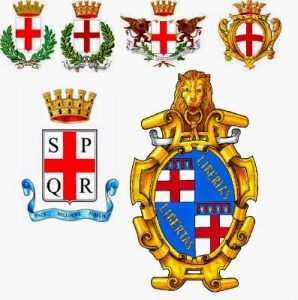
Det heraldiska korset från Guelph som ett rött kors på en vit bakgrund var inte bara armarna i Genua, utan det kan hittas på de medborgerliga armarna i traditionella Guelf-städer som Milano, Vercelli, Alessandria, Padua, Reggio och Bologna.
Vissa individer och familjer indikerade sin fraktionstillhörighet i sina vapensköldar genom att inkludera en lämplig chef: Guelphs hade en capo d'Angio eller "chef för Anjou", guld fleurs-de-lys på ett blått fält, med en röd heraldisk "etikett ”
Stadssköldarna är ett vittne till historien om de tidigare striderna mellan Guelph (Templar) och Ghibelline (Hospitaller) inriktade städer. Var och en har korsets omvända sköld. Dessa två stridande kejserliga fraktioner var ärkerivaler för det kejserliga tronen i det heliga romerska riket.
Medan olika påvar förklarade nästan ett dussin korståg mot turkarna, särskilt vid Caffa Krim, lyssnade väldigt få på samtalet. I boken "The Colonies of Genoa in the Black Sea Region", av Khvalkov, sidan 225, står det att vid biskopsrådet i Caffa, Gothia, att guelferna ansågs vara adelsmän och upprätthöll en nobel representant för Guelph där på Krim, men för Ghibelline (eller andra venetianska) nämner han dem inte som ädla representanter.
Idag har juniorkadettgrenarna i Este en dominans i detta område i Italien. Emellertid är den högsta grenen av Este Guelph Brunswick Wolfenbuettel. Detta har förblivit ett ständigt anspråk på huset, erkänt av alla parter.
Samma hus hade lämnat in framställningar till den ryska och ukrainska ambassaden om ett fredsavtal innan alltför mycket blodsutgjutelse utfärdades under Kievs maidan och nationalistiska protester 2013-2014. Det ursprungliga fredsförslaget innehöll villkor för att placera Krim under kontroll av huset Nott-Brunswick-Wolfenbuettel. I dokumentet var det huvudsakliga kravet på ukrainska rösträttar i det faktum att familjen Nott har flera rader till den ursprungliga grundaren till Kiev Rus Adel. En av dessa rader dokumenterades i korrespondensen.
House of Brunswick förblir också bunden med arvböckerna från Prince Bishops of Crimean Gothia. Detta inkluderar den nuvarande ärkebiskopen av Gothia på Krim och deras flera stift.
+ Ambrose von Sievers, från Metropolitanate of Gothia är en biskop av den sanna ortodoxa kyrkan (Russian Catacomb Church). Det är den på varandra följande kyrkan som har undgått förföljelserna från bolsjevikerna och deras på varandra följande agenter. Hans kyrka anses i vissa kretsar vara icke-kanonisk på grund av vägran att underkasta sig den KGB-installerade kyrkan. Eftersom den flyktna Andrewite-biskopen kanonikerade + Ambrose tros det därför att goternas kyrka verkligen är kanonisk till skillnad från många andra jurisdiktioner. Förföljelsen har dock fortsatt, eftersom prästerskapet har attackerats och dödats under de senaste två generationerna.
KIEV RUS GOTH DYNASTIC HEIRSHIP
|
||||||||||||||||||||||||||||||||||||
| Brunswick remained peer of Russia. co-protections remained with all Russian Monarchs. According to the primogeniture succession law 1797 re-established by Paul I of Russia, the Senior house of Wolfenbüttel-Brunswick are rightful heirs in Russian (and Dynastic, and international) law…
By numerous guarantees of Russian law, Russian Dynastic law, and Brunswick Dynastic law, and intl. treaties, these Russian estate titles of Romanov-Wolfenbuttel-Brunswick passed to the head duke of Brunswick in 1764. Charles I of Brunswick had multiple sons fighting against the illegal Russian regime in the wars that followed the murder of de jure and de facto Emperor Ivan VI von Wolfenbuttel-Brunswick in 1764. The last reigning de facto and de jure duke of Wolfenbuttel-Brunswick Charles II, was Nephew of the reigning Tsar of Russia. In multiple edicts placed death penalties on those who sought to divide his primogeniture hereditary estates, including those outside of mainland Europe. de jure princes of Wolfenbuttel Brunswick (from Ulric de Civry Wolfenbuttel forwards) include the cadet branch of the natural family that were not divorced from the natural family in edicts of Charles II. |
||||||||||||||||||||||||||||||||||||
ROYALTY OF HUNGARIAN GOTH ESTATES, AS PIAST & POLAND-LITHUANIAN SUCCESSORS
De Piast successor lines of Brunswick culminated also in the Royalty of Hungary who were the house of Angevin. The then successive rulers had claims in the realms of Transylvania, Wallachia, Moldova, and other original alloids of the Goth Nobility.
A senior Polish prince Vladislaus II had become King of Bohemia, and after having succeeded Matthias Corvinus in 1490, he also reigned as King of Hungary. Although King of Hungary, still Silesia and Moravia was retained in the hands and titles of the Corvinus family.
This line of Piasts, descendant of the Polish, Hungarian and Angevin Imperial lines, had passed down the succession of the house with the successors of Munsterberg, in Wurtemberg-Oels for Centuries. Finally when that (Württemberg) male line became extinct in 1792, it went as per the original Piast House law, that the Piast inheritance can pass by choice, and by female branches. So it passed to the last daughter and heiress Sophia Frederica Charlotte, to her husband, who upon his death passed it to his Heir, Duke Frederick William of Brunswick, from whence has continually been in the House of Brunswick-Wolfenbuettel which do this day maintains a valid status in international law as a de jure principality of the Brunswick-Wolfenbuettel-Oels government in exile.
This Silesian (and Griffin) Piast family name of Oels and coat of arms are continually used by the House of Wolfenbuttel-Brunswick, as the chief bloodline heirs of this branch. The heirship continued although there have been many occupations, including by Prussia. The occupations and usurpations have always been met with the strong legal protests, affirming the estates remain for the heirs pursuant to public, dynastic house law, treaty and international law.
The most Piast bloodlines, more than any other house culminated in the House of Wolfenbuttel-Brunswick. The only blood heir, and also the last Piast alloid principality in possession of any other monarch is known as “Oelsnica” (also the last residence of the sovereign Prussian Kaiser, during the occupation of Wolfenbuttel-Brunswick). It is retained with perpetual claim, and is used in the family name and coat of arms. Therefore several de jure sovereignty rights are preserved for Poland’s oldest Royal House and domains. The House of Wolfenbuttel-Brunswick (and by the House of Saxony) continues to maintain these basic requirements in international law.
One Piast line that founded the present bloodline of the House of Wolfenbuttel-Brunswick more here:
| Piast Imperial Dynasty (Silesian Piast Alloids and Ascanian Pomerania) |
| Bolesław I the Brave, King of Poland, Ruling Duke of Bohemia |
| Bolesław III Wrymouth Duke of Poland Silesian Piasts, Elder Branch of Piasts |
| Konrad I of Masovia, High Duke of Poland |
| Emperor Casimir III the Great, King of Poland, King of Russia |
| Emperor Louis I, King of Hungary and Croatia, King of Poland. House of Anjou(Father) and Piast (Mother) |
| Queen Jadwiga of Poland Piast – Anjou, Princess of Hungary, Grand Duchess of Lithuania, founding the Polish Lithuanian Monarchy |
| Philip II, Duke of Pomerania-Stettin (Griffin Piast and Wolfenbüttel) |
| Henry V of Wolfenbuttel, son of Henry IV and Griffin Piast Katerina of Pomerania
+ Sophia Jagiellon, Regent of Jerusalem, Duchess of Wolfenbüttel. |
| George IV William, last male of the “elder branch” Silesian Piasts |
| Clara Maria, Duchess of Pomerania, dau of Clara of Brunswick-Lüneburg, last Griffin Piast
Royal Marriage to Duke August II, of Wolfenbüttel, founder of senior branch Brunswick Wolfenbüttel |
HISTORICAL AND NEW DYNASTIC CHARTS OF THE HOUSE OF WOLFENBUTTEL-BRUNSWICK
A full chart of the Imperial lines of Dynastic succession (with several ongoing living estates and domains) is available. This presents what is supported in accepted international laws of recognition, in the family Dynastic laws concerned, in several aspects of international law and rules of prescription etc. More is available upon request by writing to marshalofsalem@yahoo.com or within the book now available on request from www.wolfenbuttel.info eller www.vonbrunswick.com (copyright 2008-present).
The membership communities of the Gothian Empire have a strong cultural and ethnic basis whose people lost their right of self-determination and freedom of association for some time. The Priory of Salem, Institute of Peace Studies offers the support we have in Jesus Christ, who with the Father and the Holy Spirit helps this neglected people to find a higher sense of value, above that which the present world system offers. Our historic areas, our institutions, and aspects of our culture still bear their names of their Gothic origins today. The Bible tells us “look to the rock from whence you were hewn”. We find much encouragement as we trace the cultural heritage out to see God fulfiling the destiny of His covenant Christian people. Many of the surrounding studies of this House and parallel order, including our House Orders, and Templar Order, is found on our blogspot. The maps of the Gothia parallel Empire states is available on request, but much information is privileged for members only. A first step would be to fill in an application at https://St-AndrewsOCC.org and begin your mission to greater inner peace and satisfaction, through the encouragement of all God has provided to the body of Christ (His people) and their continuing order for their own people (religious, spiritual, priestly and royal).
PRINCE STEPHEN, ANOINTED AS A KING (of one jurisdiction of the many Goths’ states) OF THE GOTHS AT A BERLIN CEREMONY IN 2015
At a ceremony held by the Orthodox Church Western Rite Metropolia at Berlin, Stephen d’Guelph Brunswick was anointed as a titular King of the Goths(only one of many local Gothia jurisdictions), as an Emperor Elect, and as a Prince-Elector (an equal Elector on the Gothian Empire) high prince of his local jurisdiction (Benelux), at the formation and constitution signing for the re-founding of this order. http://gothiantemplar.blogspot.nl.
- House of Brunswick European Imperial Restoration Gains Popularity in Germany, France, Poland and Ukraine
- Brunswick Continuing Knights Templar House of the Original Angevin Royals’ branch, with full Royal protections of the Templar, incl. fons honorum
Other jurisdictions of the Goths also have (as demonstrated) had their own Kings of Goths at their local region. As Electors these titles may vary but are typically “Prince-Elector” and may hold dual local titles. In this case as a Brunswick heir of the local jurisdiction for the church which included various tribes, such as the Burgundian Goths. His forefather Otto IV von Brunswick was also King of Burgundy. So this title was most appropriately placed for this particular jurisdiction of Goths (at Benelux) and put into the founding charter documents co-signed by six other Imperial Electors. The election was set 10 years prior in official documents. The rank of Emperor can only become effective when there are twelve aethelings electing him (voting) for his rotation to head a true Germanic Imperial Diet. This is the ancient way which always ran parallel to the Holy Roman Empire.
Heirs of other Gothian States who can claim some form of de facto or de jure inheritance are also welcome to join our wider tribal order. The traditional and cultural representation of our Gothian States is in vital need of rekindling. The cultural representation in Brunswick, spanning more than 1,000 years is one valuable aspect of our order. The states include regions anywhere in the world where there is some kinship to the tribes of the Goths. As Brunswick has held a flag in most corners of the earth, including Australia, Canada, South Africa, etc, the tribe’s representation may be lacking. This ceremonial order for the local region may help booster morale and encourage more development of our cultural Christian civilization. The working together and having our own system and economy is important for our future success as a smaller tribal people.
The Templar of Gothia jurisdictions was then founded as an independent Order. Each Imperial Elector was automatically made a Grand Commander of their local jurisdiction. Gothia jurisdiction is not required to join the Templar but it is one of many options. Such as the Brunswick Order of Templar Portugal’s order etc. If it’s not with a Royal protector that has true sovereignty, then we can’t fully endorse them as knights, but would offer to integrate them into either order to gain this valuable level of Royal protection of international sovereignty within the Brunswick jurisdiction eller Gothia jurisdiction.
militie templi iurisdictiones gothorum imperii
Knights Templar of Gothia. As established by the Prince of Gothia in 1099 under his kinsmen, the first 11 Angevin Kings of Jerusalem, and consecrated between hands of the Patriarchs of Constantinople and Jerusalem. Inherited by Wolfenbuttel-Brunswick, represented by Imperial Knights of Gothia, in allegiance to the Dynastic Heirs of the Angevin and Gothian House. With the aim to advance the Christian religion, restoring Jerusalem, and protecting our pilgrims as they worship at our holy sites.
BILAGA
Ottoniska kejsarseglar (används idag i Brunswick heraldik)
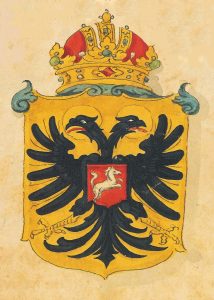
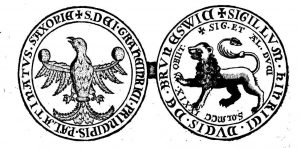
Sälar av Otto IV av Brunswick
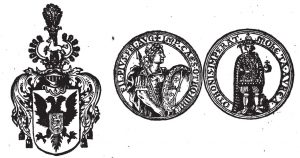
Hertig Otto av Brunswick, kejsare av det heliga romerska riket

Ryska kejsaren Ivan VI Brunswick-Wolfenbuettel-Romanov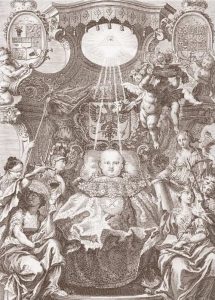

Fler artiklar om detta och omgivande ämnen finns på www.celticorthodoxy.com
Praise YAHWEH every day for each victory as we do as Jesus Christ told us to pray, and to ordered us to “seek first His Kingdom law governance on earth”. May Jesus Christ soon come back to find us worthy to be His subjects, vassals, princely true Israel Nationalists, and thengs, at His Jerusalem government when He shall reign as King of kings and our Lord of lords.
This article is a mere sampling of the upcoming book to be made available at http://wolfenbuttel.info http://www.vonbrunswick.com (Copyright 2008 – Present).
Subscribers will have continued public service updates that include highly informational videos (now mostly for members only). You’ll learn how to get involved at local levels, as well as to vote and seek the self representation, self determination and freedom of association at is enshrined as a human right everywhere in the world (and is now the least claimed, but vitally important for future peace and prosperity).


